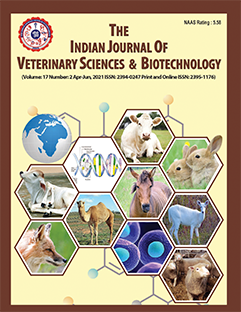Antimicrobial Resistance Profiles of Bacterial Isolates from Clinical Cases in Livestock and Poultry
DOI:
https://doi.org/10.48165/ijvsbt.21.6.28Keywords:
Antimicrobial resistance, Livestock, Multidrug, Poultry, Prevalence, UdaipurAbstract
This study investigated the antimicrobial resistance profiles of bacterial isolates from clinical cases in ruminants (n=163) and poultry (n=64). In ruminants, Staphylococcus aureus exhibited the highest resistance to penicillin-G (85.45%), tetracycline, and polymyxin-B (80% each). Streptococcus spp. showed the greatest resistance to polymyxin-B (100%) and methicillin (86.67%). E. coli isolates displayed maximum resistance to penicillin-G, cephalothin, methicillin, and vancomycin (100% each), while Salmonella isolates were resistant to methicillin (100%), vancomycin (85.71%), and polymyxin-B (85.71%). All Corynebacterium spp. were fully resistant to nitrofurantoin, and all Pseudomonas isolates were resistant to ampicillin, nitrofurantoin, penicillin-G, methicillin, tetracycline, and vancomycin. In poultry, E. coli exhibited complete resistance to nitrofurantoin, vancomycin, penicillin-G, methicillin, and cephalothin, followed by tetracycline (88%), co-trimazole (88%), polymyxin-B (84%), and ampicillin (80%). Salmonella isolates were resistant to methicillin (100%), vancomycin (80%), polymixin-B (80%), and ampicillin and co-trimoxazole (73.33%). Proteus mirabilis exhibited high resistance to penicillin-G, methicillin, tetracycline, nitrofurantoin, vancomycin, and cephalothin (100% each), followed by co-trimazole (91.67%) and polymyxin-B (88.33%). Klebsiella isolates showed over 90% resistance to penicillin-G, polymyxin-B, vancomycin, methicillin, cephalothin, and ampicillin. Antimicrobials penicillin-G, methicillin, tetracycline, co-trimoxazole, ampicillin, vancomycin, and amoxicillin-clavulanic acid exhibited 100% high resistance in Pseudomonas isolates. The least resistance was observed in all isolates to gentamicin, ciprofloxacin, ofloxacin, chloramphenicol, amoxicillin-clavulanic acid, and azithromycin.
Downloads
References
Aarestrup, F. M. (2015). The livestock reservoir for antimicrobial resistance: A personal view on changing patterns of risks, effects of interventions and the way forward. Philosophical Transactions of the Royal Society B: Biological Sciences, 370(1670), 20140085.
Ajayi, A. O., Odeyemi, A., Akinjogunla, O. J., Adeyeye, A. B., & Ayo-Ajayi, I. (2024). Review of antibiotic-resistant bacteria and antibiotic resistance genes within the one health framework. Infection Ecology & Epidemiology, 14(1), 2312953.
Ayukekbong, J. A., Ntemgwa, M., & Atabe, A. N. (2017). The threat of antimicrobial resistance in developing countries: Causes and control strategies. Antimicrobial Resistance and Infection Control, 6(1), 47.
Bengtsson, B., & Greko, C. (2014). Antibiotic resistance - Consequences for animal health, welfare, and food production. Upsala Journal of Medical Sciences, 119(2), 96.
Frye, J. G., & Jackson, C. R. (2013). Genetic mechanisms of antimicrobial resistance identified in Salmonella enterica, Escherichia coli, and Enterococcus spp. isolated from U.S. food animals. Frontiers in Microbiology, 4, 135.
Hedman, H. D., Vasco, K., & Zhang, L. (2020). A review of antimicrobial resistance in poultry farming within low-resource settings. Animals, 10(8), 1264.
Johnson, D. I. (2017). Staphylococcus spp. In Springer eBooks. Springer Nature, p. 127.
Li, J., Xie, S., Ahmed, S., Wang, F., Gu, Y., Zhang, C., Chai, X., Wu, Y., Cai, J., & Cheng, G. (2017). Antimicrobial activity and resistance: Influencing factors. Frontiers in Pharmacology, 8, Article 364.
Nair, D. V. T., Venkitanarayanan, K., & Johny, A. K. (2018). Antibiotic resistant Salmonella in the food supply and the potential role of antibiotic alternatives for control. Foods, 7(10), 167.
Pulingam, T., Parumasivam, T., Gazzali, A. M., Sulaiman, A. M., Chee, J. Y., Lakshmanan, M., Chin, C. F., & Sudesh, K. (2021). Antimicrobial resistance: Prevalence, economic burden, mechanisms of resistance and strategies to overcome. European Journal of Pharmaceutical Sciences, 170, 106103.
Rossi, C. C., Pereira, M. F., & Giambiagi-deMarval, M. (2020). Underrated Staphylococcus species and their role in antimicrobial resistance spreading. Genetics and Molecular Biology, 43(1 suppl 2), e20190065.
Tepper, V. (2018). Antimicrobial resistance in E. coli from Swedish calves and the surrounding environment (Master’s dissertation). University of Sweden, Sweden.
Varga, C., Guerin, M. T., Brash, M. L., Slavić, Ð., Boerlin, P., & Susta, L. (2019). Antimicrobial resistance in fecal Escherichia coli and Salmonella enterica isolates: A two-year prospective study of small poultry flocks in Ontario, Canada. BMC Veterinary Research, 15(1), 464.
Verraes, C., Boxstael, S. V., Meervenne, E. V., Coillie, E. V., Butaye, P., Catry, B., Schaetzen, M.-A. de, Huffel, X. V., Imberechts, H., Dierick, K., Daube, G., Saegerman, C., Block, J. D., Dewulf, J., & Herman, L. (2013). Antimicrobial resistance in the food chain: A review. International Journal of Environmental Research and Public Health, 10(7), 2643.
White, D. G., Zhao, S., Simjee, S., Wagner, D. D., & McDermott, P. F. (2002). Antimicrobial resistance of foodborne pathogens. Microbes and Infection, 4(4), 405.
Downloads
Published
Issue
Section
License
Copyright (c) 2025 Indian Journal of Veterinary Sciences and Biotechnology

This work is licensed under a Creative Commons Attribution-NonCommercial-NoDerivatives 4.0 International License.




